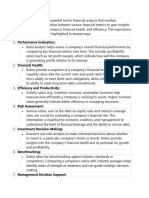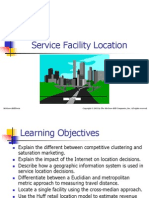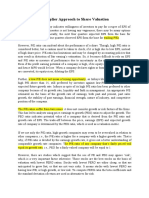Market Segmentation For Automobiles
Market Segmentation For Automobiles
Uploaded by
Nitin JainCopyright:
Available Formats
Market Segmentation For Automobiles
Market Segmentation For Automobiles
Uploaded by
Nitin JainOriginal Description:
Original Title
Copyright
Available Formats
Share this document
Did you find this document useful?
Is this content inappropriate?
Copyright:
Available Formats
Market Segmentation For Automobiles
Market Segmentation For Automobiles
Uploaded by
Nitin JainCopyright:
Available Formats
Market segmentation for automobiles
In todays times, the automobile sector is robust with growth and more and more players are entering the automobile
industry. The meaning of market segmentation was discussed in the last post and here an attempt has been made to
get an overview of the market segmentation of automobiles.
Geographic segmentation
Geographical segmentation is one of the most important basis of segmentation of the automobile sector, especially
in large sized countries like India, where the conditions in different regions.
Taking the segmentation in India itself, we find that manufactures of tractors would focus only on those areas where
agriculture is of prime importance and would target those agriculturists who have sizeable land holdings and have
the resources to buy a tractor.
On the other hand, commercial vehicle companies would segment the market on the basis of concentration of
industries in different regions.
Luxury car makers would definitely target the metropolitan regions for the sale of their cars, whereas small car
makers would also take into account developing cities and townships into account during the process of
segmentation of their products.
Demographic segmentation
Another important basis for segmentation of the automobile sector is demographic segmentation. Demographic
segmentation provides a base marketing of products according to the income, status, age, etc.
Manufactures of small cars like Nano would primarily focus on the segment of the people belonging to the middle
class and here comes lies the demographic segmentation. On the other hand, luxury car manufacturers would focus
more on the high income segment.
Similarly, demographic segmentation plays an important role in the two wheeler market. Bike manufacturers
generally target young to middle aged people. More and more manufactures are coming with automobiles for
women, which have special features and are easy to use.
According to the age of the target market group, automobile manufacturers would come up with different colour
variants, for instance bright and flashy colours for the young and vice versa.
Psychological segmentation
Based on psychological segmentation, automobile manufacturers come up with different variant of the models of
their products. This has been largely seen in the case of cars, where companies generally come up with two or three
variants of the same model, and it has been observed by industry analysts that the variant of the medium variant of
the model sells the most.
Tag-lines such as Men are Back (used by Maruti Suzuki for the launch of a new car) and Definitely Male (used
by Bajaj for a popular bike) target a particular category of individuals and help to increase sales and popularity in
that segment.
Manufacturers of luxury cars like Ferrari, Porsche, etc target the section of the society with a large disposable
income and high status, and this can be achieved by psychological segmentation.
Behavioural segmentation
As mentioned earlier, behavioural segmentation is done on the basis of the benefits sought, loyalty status, etc.
This is another important means for segmentation in the automobile sector, and taking yet again the example of a
car, Daimler, the manufacturer of luxury car Maybach, customises the cars according to the needs and requirements
of the products.
FURTHER SEGMENTATION
The Indian car market has enjoyed a robust growth rate in the past and at present is the sixth
biggest passenger and commercial vehicle producer in the world. In the fiscal year 2011 2012
almost three million passenger cars were sold in the sub-continent.
Naturally proper segmentation of the Indian cars is a dire necessity. This segmentation allows for
automobile manufacturers to plan and position their models for succeeding in the targeted consumer
section precisely. Also a proper segmentation of the different models of cars is required to levy
proper taxes by government of India on them.
There are different parameters based on which the cars available in the Indian market are
categorized. The technically defining parameters are based on the length of the car, engine capacity,
features offered, seating capacity and structure of the car etc.
SIAM or Society of Indian Automobile Manufacturers divides the Indian passenger vehicles in the
segments A1, A2, A3, A4, A5, A6, B1, B2 and SUV. The classification is done solely based on the
length of the automobiles. The details of the segments are mentioned as below..
Car Segment Length of the car/Model type Car model belonging to the segment
A1 Up to 3400mm Nano
A2 3401 to 4000mm Alto, i10, Zen, Wagon R
A3 4001 to 4500mm Manza, Logan, Dzire, City
A4 4501 to 4700mm Corolla, Octavia, Optra
A5 4701 to 5000mm Accord, Camry, Sonata
A6 More than 5000 mm Mercedes S class
B1 Vans Versa, Omni
B2 MUV/MPV Sumo, Innova
SUV SUV Vitara, CRV
However, though it is simple and easy to divide the passenger cars based on their length, it is not at
all practical. The price of a car isnt determined by length only. A shorter car might be priced higher
than a lengthier model. Also the features and configuration of the car models doesnt depend on the
car length.
Hence, to avoid all the confusions the Indian passenger cars are popularly divided into the below
mentioned segments according to the following properties.
Car Segment Distinguishing feature of the cars in this segment Car model belonging to the segment
A Cars priced below Rs. 3.5 Lakh Alto, Spark, Nano, Eon
A1 Hatchback priced lower than Rs. 6 Lakh Santro, Indica, Beat
A2 Hatchback priced between Rs. 6 to 7.5 Lakh Ritz, i10, i20, Swift, Figo
B1 Vans Versa, Omni
B2 MUV/MPV Sumo, Innova
C1 Sedan models priced below Rs. 8 Lakh Indigo, Fiesta, Sunny
C2 Sedan models priced between Rs. 8 to 9.5 Lakh Verna, Manza, Linea
D1 Premium Sedan models priced below Rs. 15 Lakh Fluence, Corolla
D2 Luxury Sedan models priced below Rs. 25 Lakh Sonata, Camry, Kizashi
SUV SUV Vitara, CRV
Body type is the other most popular factor for classification of passenger vehicles. This
segmentation process is not only limited to the Indian sub-continent, this is a common method that
enjoys popularity throughout the world.
The popular segments according to the car body types are mentioned as below.
Mini
Compact
hatchback
mid size cars
Sedan
executive cars
premium cars
luxury cars
super luxury cars
van
utility vehicles
MUV/MPV
SUV
convertibles
sports cars
super cars
You might also like
- Mazda B2500 Manual de Taller: Read/DownloadDocument3 pagesMazda B2500 Manual de Taller: Read/DownloadAurora González33% (6)
- AC COBRA 427 Build ManualDocument93 pagesAC COBRA 427 Build ManualAnonymous VbAh6ENz100% (2)
- Badland Buggy - ST3 Two Seater Buggy Plans (Chassis Only) PDFDocument16 pagesBadland Buggy - ST3 Two Seater Buggy Plans (Chassis Only) PDFFernando Gahyva75% (4)
- Toyota 2TRDocument3 pagesToyota 2TRAllvaro Torrico100% (1)
- Module 2 - Concept of Global Marketing & Global Marketing StrategyDocument18 pagesModule 2 - Concept of Global Marketing & Global Marketing StrategyAriel Bobis100% (1)
- Marketing Mix of FoodpandaDocument6 pagesMarketing Mix of Foodpandakazim shahNo ratings yet
- VW Passat B6 2005 - Steering, Torque SpecificationsDocument1 pageVW Passat B6 2005 - Steering, Torque SpecificationsNPNo ratings yet
- Forza 4 Tuning Calculator (March 2012)Document12 pagesForza 4 Tuning Calculator (March 2012)sat49ersfanNo ratings yet
- Price SegmentationDocument13 pagesPrice SegmentationTerra TuckerNo ratings yet
- Final Economics AssignmentDocument6 pagesFinal Economics Assignmentmashraf_397037No ratings yet
- Three Topics-1Document43 pagesThree Topics-1GangothriNo ratings yet
- Unit 4 Dividend DecisionsDocument17 pagesUnit 4 Dividend Decisionsrahul ramNo ratings yet
- Business Economics Cia - 1: Q1. Do You Think Aston Martin Car Presents An Exception To The Law of Demand? If Yes, ExplainDocument4 pagesBusiness Economics Cia - 1: Q1. Do You Think Aston Martin Car Presents An Exception To The Law of Demand? If Yes, ExplainWali HaiderNo ratings yet
- Marketing Mix - PriceDocument6 pagesMarketing Mix - PriceRagulan100% (2)
- 2.leverage - Meaning and Its Types (With Formula) PDFDocument10 pages2.leverage - Meaning and Its Types (With Formula) PDFMADHAN KUMAR PARAMESWARANNo ratings yet
- Marketing Mix Analysis of Ford Motor CompanyDocument13 pagesMarketing Mix Analysis of Ford Motor Companyfarahnaz100% (1)
- Defining The Competitive SetDocument16 pagesDefining The Competitive SetZenedel De JesusNo ratings yet
- An Overview of Financial SystemDocument6 pagesAn Overview of Financial SystemAshwani BhallaNo ratings yet
- SCM - Unit-1Document20 pagesSCM - Unit-1Aashish Singh IINo ratings yet
- Mission & Vision of Diffferent CompanyDocument8 pagesMission & Vision of Diffferent CompanyMuniba Islam100% (1)
- Competitive Analysis and MarketingDocument9 pagesCompetitive Analysis and MarketingUniq ManjuNo ratings yet
- Multinational CorporationDocument23 pagesMultinational CorporationRahul VermaNo ratings yet
- Supply Network DesignDocument13 pagesSupply Network DesignNehari Senanayake0% (1)
- Chapter 1 Relationship Selling Opportunities in The Information EconomyDocument7 pagesChapter 1 Relationship Selling Opportunities in The Information EconomykathernNo ratings yet
- Executive SummaryDocument42 pagesExecutive Summarysherrysher820% (2)
- iMPORTANCE OF RATIO ANALYSISDocument2 pagesiMPORTANCE OF RATIO ANALYSISPremiNo ratings yet
- 1-Product/ Service FeasibilityDocument4 pages1-Product/ Service Feasibilityusama ilyasNo ratings yet
- Undifferentiated Marketing Differentiated Marketing Concentrated Targeting Customized MarketingDocument5 pagesUndifferentiated Marketing Differentiated Marketing Concentrated Targeting Customized MarketingTekletsadik TeketelNo ratings yet
- Consumer AttitudeDocument25 pagesConsumer AttitudeChetal Bhole0% (1)
- JaguarDocument24 pagesJaguarankita5667% (3)
- Product and Pricing Module 3Document12 pagesProduct and Pricing Module 3irshad_cbNo ratings yet
- Cost Accounting Lecture NotesDocument12 pagesCost Accounting Lecture NotesMd. Ahsanur RahmanNo ratings yet
- Basic MicroeconomicsDocument219 pagesBasic Microeconomicsloc dinhNo ratings yet
- Research PaperDocument97 pagesResearch Paperakshay gangwaniNo ratings yet
- Automobile IndustryDocument25 pagesAutomobile IndustryAneeka Niaz0% (1)
- Size of Industrial Units in IndiaDocument19 pagesSize of Industrial Units in IndianeetikaNo ratings yet
- Financial Derivatives Notes MBADocument87 pagesFinancial Derivatives Notes MBAnaren mishraNo ratings yet
- Certainty Equivalent FactorDocument2 pagesCertainty Equivalent FactorParth SahniNo ratings yet
- Commodity Approach or Product ApproachDocument2 pagesCommodity Approach or Product Approachswati joshiNo ratings yet
- Business Location and Success:: The Case of Internet Café Business in IndonesiaDocument22 pagesBusiness Location and Success:: The Case of Internet Café Business in IndonesiaRichard Rhamil Carganillo Garcia Jr.100% (1)
- Chap10-Service Facility LocationDocument15 pagesChap10-Service Facility LocationFez MunozNo ratings yet
- PRINCIPLES OF MARKETING - UNIT 4 Pricing and DistributionDocument96 pagesPRINCIPLES OF MARKETING - UNIT 4 Pricing and DistributionYoNo ratings yet
- What Is Business EnvironmentDocument6 pagesWhat Is Business EnvironmentAjay KumarNo ratings yet
- Presentation On Logistic System Analysis and DesignDocument9 pagesPresentation On Logistic System Analysis and DesignAnshuman ParasharNo ratings yet
- Competitive Dynamics TheoryDocument1 pageCompetitive Dynamics TheoryMaxine100% (1)
- Demand Survey of Hyundai Motors Ltd.Document5 pagesDemand Survey of Hyundai Motors Ltd.Prince KaliaNo ratings yet
- Entreprenuership AssignmentDocument15 pagesEntreprenuership AssignmentBhavyata VermaNo ratings yet
- Nidhishree Part2 (3) PDFDocument51 pagesNidhishree Part2 (3) PDFDeepti NayakNo ratings yet
- Marketing ManagementDocument29 pagesMarketing ManagementDaksh DawarNo ratings yet
- Retail Marketing SegmentationDocument15 pagesRetail Marketing Segmentationmohammed nizar89% (9)
- Marketing Mix - Place NotesDocument10 pagesMarketing Mix - Place NotesFarrukhsgNo ratings yet
- Chapter - 2 (International Flow of Funds)Document23 pagesChapter - 2 (International Flow of Funds)shohag30121991100% (1)
- Q: How Would You Examine If There Is Any Merit in The Remarks of Various Functional Managers?Document3 pagesQ: How Would You Examine If There Is Any Merit in The Remarks of Various Functional Managers?Kamakshi KhannaNo ratings yet
- OLA Cabs Swot AnalysisDocument11 pagesOLA Cabs Swot Analysisoreo kumar100% (2)
- Industrial Management ModelDocument2 pagesIndustrial Management Modelrajendrakumar100% (1)
- Individual Product DecisionsDocument31 pagesIndividual Product DecisionsrohitbatraNo ratings yet
- Unit IV - (Managerial Economics) Market Structures & Pricing StrategiesDocument37 pagesUnit IV - (Managerial Economics) Market Structures & Pricing StrategiesAbhinav SachdevaNo ratings yet
- Multiplier Approach To Share ValuationDocument2 pagesMultiplier Approach To Share ValuationI am IndianNo ratings yet
- OLIGOPOLYDocument11 pagesOLIGOPOLYShweta ShrivastavaNo ratings yet
- Market Structures AssignmentDocument3 pagesMarket Structures AssignmentDilantha ShaluthaNo ratings yet
- Airtel Org SstructureDocument5 pagesAirtel Org SstructureAntuvane AntuNo ratings yet
- CHAPTER 3 - Marketing PPT MGMTDocument41 pagesCHAPTER 3 - Marketing PPT MGMTrtNo ratings yet
- Value Chain Management Capability A Complete Guide - 2020 EditionFrom EverandValue Chain Management Capability A Complete Guide - 2020 EditionNo ratings yet
- Maruthi SuzukiDocument16 pagesMaruthi SuzukiSreelakshmi.vNo ratings yet
- Segmentation, Targeting and Positioning of Maruti SuzukiDocument10 pagesSegmentation, Targeting and Positioning of Maruti SuzukiAnshuman Upadhyay83% (6)
- Analysis The Growth Prospectus of Middle Segment Cars in PunjabDocument10 pagesAnalysis The Growth Prospectus of Middle Segment Cars in PunjabashutosdrawatNo ratings yet
- Thrillophilia Invoice DetailsDocument12 pagesThrillophilia Invoice DetailsNitin JainNo ratings yet
- Best ProductsDocument4 pagesBest ProductsNitin JainNo ratings yet
- Mayank ThailandDocument4 pagesMayank ThailandNitin JainNo ratings yet
- Answer 1Document4 pagesAnswer 1Nitin JainNo ratings yet
- Sentosa Fun Pass: Ticket Option Days of Operation Pick-Up TimeDocument1 pageSentosa Fun Pass: Ticket Option Days of Operation Pick-Up TimeNitin JainNo ratings yet
- Bass, B. M., & Stogdill, R. M., 1990)Document5 pagesBass, B. M., & Stogdill, R. M., 1990)Nitin JainNo ratings yet
- 032431986X 104971Document5 pages032431986X 104971Nitin JainNo ratings yet
- CapProExample (1) 111111Document2 pagesCapProExample (1) 111111Nitin JainNo ratings yet
- Womenswear SheetDocument14 pagesWomenswear SheetNitin JainNo ratings yet
- Menswear SheetDocument15 pagesMenswear SheetNitin JainNo ratings yet
- Edu CompDocument6 pagesEdu CompNitin JainNo ratings yet
- Summer Internship - Application Form - Metro Cash & CarryDocument3 pagesSummer Internship - Application Form - Metro Cash & CarryNitin JainNo ratings yet
- Sanjayjha CVDocument3 pagesSanjayjha CVNitin JainNo ratings yet
- Rules Regarding DM AssignmentsDocument1 pageRules Regarding DM AssignmentsNitin JainNo ratings yet
- Consumermotivationononlineshopping 140208015200 Phpapp01Document45 pagesConsumermotivationononlineshopping 140208015200 Phpapp01Nitin JainNo ratings yet
- Softelectronic PresentationDocument18 pagesSoftelectronic PresentationKhristina Stefanova100% (1)
- A Story Behind..: Dimas Budi Satria Wibisana Mario Alexander Industrial Engineering 5Document24 pagesA Story Behind..: Dimas Budi Satria Wibisana Mario Alexander Industrial Engineering 5Owais AwanNo ratings yet
- Operating Manual - ASC 150 Murphy Cummins Tier 3 - enDocument1 pageOperating Manual - ASC 150 Murphy Cummins Tier 3 - enIhorNo ratings yet
- KYB Catalogue PDFDocument314 pagesKYB Catalogue PDFMohd ShaizanNo ratings yet
- Toyota 86Document31 pagesToyota 86Roberto Ortega MicalizziNo ratings yet
- Dash Programmer PDFDocument48 pagesDash Programmer PDFWassef ChaabenNo ratings yet
- Project Report ON: "A Study of Consumer Behaviours and Satisfaction With Hyundai Motors"Document105 pagesProject Report ON: "A Study of Consumer Behaviours and Satisfaction With Hyundai Motors"Mayank AgrawalNo ratings yet
- Fram Catalogo 2010Document422 pagesFram Catalogo 2010CDECOSSG100% (1)
- BMW 1 Series 2010 - Google Search PDFDocument1 pageBMW 1 Series 2010 - Google Search PDFDomas NėniusNo ratings yet
- 04 Komatsu GD825 Engine SystemDocument34 pages04 Komatsu GD825 Engine SystemLucyan Ionescu100% (3)
- Key Pro m8 Auto Key Programmer Support Vehicle List PDFDocument143 pagesKey Pro m8 Auto Key Programmer Support Vehicle List PDFJustin MooreNo ratings yet
- List of Current Automobile Manufacturers by Country - WikipediaDocument7 pagesList of Current Automobile Manufacturers by Country - Wikipediasasank pylaNo ratings yet
- Atf Conversion Chart - HFM & M-V Ts-As-05-112-FtDocument2 pagesAtf Conversion Chart - HFM & M-V Ts-As-05-112-FtcherokewagNo ratings yet
- 1966 Comet Falcon Fairlane Mustang Manual 001-150Document150 pages1966 Comet Falcon Fairlane Mustang Manual 001-150shit100% (2)
- Comfort BucharestDocument14 pagesComfort BucharestBogdanNo ratings yet
- Sparkplugs CommercialDocument22 pagesSparkplugs Commerciallongtrandang5867No ratings yet
- Gates Timing BeltsDocument180 pagesGates Timing BeltsPraveen KN Acharya75% (4)
- Trip ComputerDocument19 pagesTrip ComputeraurelienNo ratings yet
- Wheels - November 2024 AUDocument132 pagesWheels - November 2024 AUhospitalmaranatha4No ratings yet
- Commodore VIN Decoder (VB To ZB)Document10 pagesCommodore VIN Decoder (VB To ZB)scottandsarahcarrNo ratings yet
- Jadwal Mesin-Div. Jasa-Juli-Mg.2Document1 pageJadwal Mesin-Div. Jasa-Juli-Mg.2KPI D 2017No ratings yet
- COIN & MONEY V4.8.18.3.luaDocument7 pagesCOIN & MONEY V4.8.18.3.luads908070No ratings yet
- A Company Case Study On "Ford"Document14 pagesA Company Case Study On "Ford"ravi pratap0% (1)
- The All-New Audi E-TronDocument4 pagesThe All-New Audi E-TronDigital SEM100% (1)








































































































